Meu SciELO
Serviços Personalizados
Journal
Artigo
Indicadores
-
 Citado por SciELO
Citado por SciELO -
 Acessos
Acessos
Links relacionados
-
 Citado por Google
Citado por Google -
 Similares em
SciELO
Similares em
SciELO -
 Similares em Google
Similares em Google
Compartilhar
Archivos Españoles de Urología (Ed. impresa)
versão impressa ISSN 0004-0614
Arch. Esp. Urol. vol.62 no.7 Set. 2009
Urological conservative management of a patient with tuberous sclerosis complex (Bourneville Disease)
Manejo conservador urológico de una paciente con esclerosis tuberosa compleja (Bourneville)
Jorge Sague Larrea, Luis Borrego Pino, Rene Salas Cabrera and Ariel Laurencio Mena
Department of Urology. Hospital V.I. Lenin. Reparto Luz. Holguin. Cuba.
SUMMARY
Objective: To report the clinical and radiological data of a 23-year-woman with bilateral angiomyolipoma and Tuberous Sclerosis with conservative treatment.
Methods: The patient underwent conservative urological management, based on clinical and complementary tests' data (ultrasonography, CT scanning, excretory urogram, and laboratory). Monitoring was carried out in external consultation by the uroncology group. In some occasions she was hospitalized due to distant geographical factors.
Results: This patient provides long-term outcome of AML with Tuberous Sclerosis followed by repeated evaluation to define the conservative management or not. Ultrasonound and CT scan were two basic studies to maintain conservative treatment, as well as a good clinical evaluation.
Conclusions: Renal lesions associated with tuberous sclerosis are frequent and serious. Monitoring should be based on a careful monitoring since the renal lesions are the second death cause after the lesions of the nervous system. This case report provides long-term outcome of AML with tuberous sclerosis, that can be followed expectantly with repeated evaluations to define the clinical significance.
Key words: Angiomyolipoma. Sclerosis tuberous.
RESUMEN
Objetivo: Ofrecer datos clínicos e imageneológicos de una enferma con Esclerosis Tuberosa Compleja seguida durante 22 años por urología. Revisar las implicaciones urológicas en esta enfermedad.
Métodos: La paciente realizó tratamiento médico conservador urológico, basado en la clínica y los complementarios (ultrasonido, urograma descendente, TAC, humorales). El seguimiento fue realizado en consulta externa por el grupo de Uroncologia. En algunas ocasiones fue ingresada para estudio debido a factores geográficos distantes.
Resultados: Esta paciente con Angiomiolipoma y Esclerosis Tuberosa ha tenido larga evolución basada en evaluaciones repetidas para mantener o no el tratamiento conservador. El ultrasonido y la TAC fueron dos estudios básicos para mantener conducta no quirúrgica, así como una buena evaluación clínica.
Conclusiones: Las manifestaciones renales son frecuentes y serias. El seguimiento deberá basarse en un monitoreo cuidadoso ya que las lesiones renales son la segunda causa de muerte después de las lesiones del sistema nervioso. Este reporte de larga evolución en una paciente con esclerosis tuberosa acompañada de angiomiolipoma bilateral demuestra que algunos pueden ser seguidos con exámenes clínicos repetidos hasta definir el momento en que debemos cambiar de conducta.
Palabras clave: Angiomiolipoma. Esclerosis tuberosa.
Introduction
Tuberous sclerosis is an autosomal dominant condition described for the first time in 1 880, can affect multiple organs, causing tumors in kidneys, skin, brain, heart, eyes, lung, teeth as well as in other organs and systems (1).
In most cases affects only some of those organs. The severity understands since small abnormalities in the skin to serious cases with mental retardation or renal failure. Many demonstrations can be developed late in the life of the patient.
Due to the improvement in the test to detect these illnesses their frequency enlarges to expenses fundamentally of cases with clinical manifestation serious. Prevalence of the population: 1/9,407 cases. Incident: 1/6000 births. Occurs in both sexes, all the races and ethnic groups.
Case report
A case of bilateral angiomyolipoma (AML) with tuberous sclerosis in a 23-year-old diagnosed from girl is reported. Clinical complaints were mainly bilateral lumbar pain and flank palpable mass, mental retardation, epilepsy, adenoma sebaceum (Figure 1).
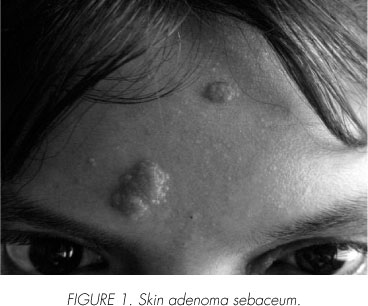
Diagnostic techniques: Angiomyolipomas was diagnosed ultrasonography (Figure 2), brain CT scanning (Figure 3), renal CT scanning (Figures 4 and 5), biopsy of skin and excretory urography. The following of this patient has been during the last 10 years in our institution by the same group of urologist.
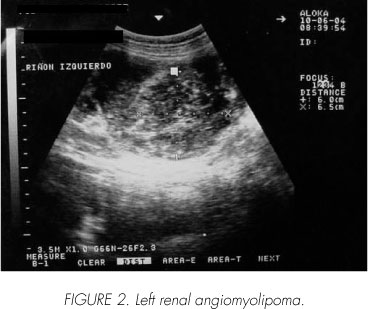
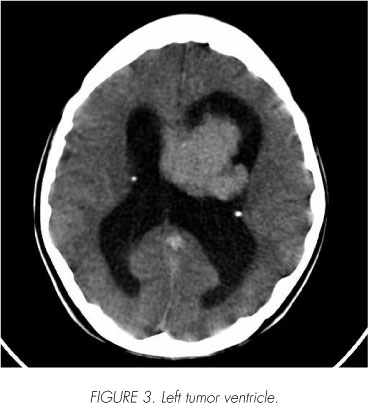
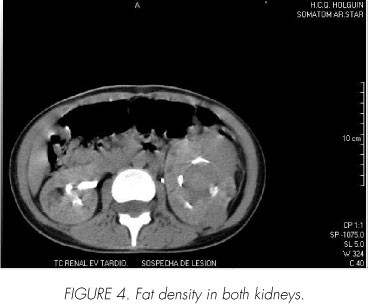
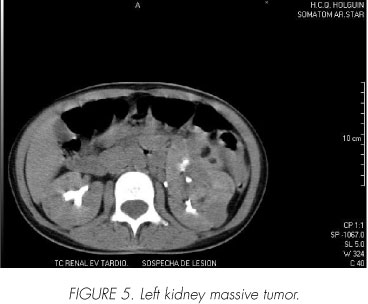
Discussion
Since the point of view urological the presence of bilateral renal tumors (angiomyolipoma)- secondary judgment for the diagnostic-has been well supported by the patient, not causing symptoms. The other renal lesions could to shape of cysts, angiomyolipoma , oncocytoma and renal carcinoma (2).
The patients with Sclerosis Tuberous and angiomyoli-poma renal, they have greater renal risk to develop malignant growths that the individual that only presents angiomyolipoma (3). The renal carcinoma is seen seldom but when they exist often they are bilateral and multicentric. The cysts are commonly multiple and bilateral. Some cysts can to stop and to disappear. They are used to appearing in early phase of the illness. The producing gene is the TSC 2 in the chromosome 16.
The oncocytoma is a benign tumor occasionally seen in these patients. The spontaneous break of the angiomyo-lipoma is a dramatic event, being accompanied many times of intense pain in the side (4). The hemorrhage can be intratumoral, subcapsular or peri renal (5). The elements to keep in mind for the surgical processing are the intense pain, bleeding and suspects of malignancy (6,7).
Conclusions
The renal lesions are frequent and serious. The monitoring should base on a careful monitoring since the renal lesions are the death cause second after the lesions of the nervous system (8-10). This case report provide long-term outcome of AML with tuberous sclerosis can be followed expectantly with repeat evaluation to define the clinical significance.
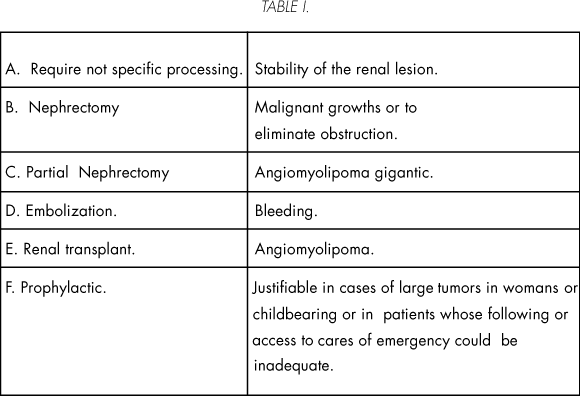
 Correspondence:
Correspondence:
Jorge Sague Larrea
Hospital V.I. Lenin
Section of Urologia
Calle Luz 38
e/Carretera de Gibara y Paz
Reparto Luz. Holguin.80300 (Cuba)
Sague@cristal.hlg.sld.cu
Accepted for publication: February 24th, 2009.
References and recomended readings (*of special interest, **of outstanding interest)
*1. Lendvay TS, Marshall FF. The tuberous sclerosis complex and its highly variable manifestation. J Urol 2003 May; 169(5): 1636-42. [ Links ]
2. Freyer AE, Osborne JP. Tuberous Sclerosis: a clinical appraisal. Pediatr Rev Commun 1997; 1:239-40 [ Links ]
3. Takahashi N, Kitahara R, Hishimoto Y, Oghuro A, Hashimoto Y, Susuki T. Transformation of renal angiomyolipoma. Int J Urol 2003 May; 10(5): 271-3. [ Links ]
4. Hamaguchi T, Kasahara K, Shuin T, Katapka S. Spontaneous rupture of renal angiomyolipoma with tuberous sclerosis during long-term follow-up:ac. Hinyokika Kujo 2001 Sep; 47(9):645-8. [ Links ]
5. Yu DS, Wu CJ, Chang SY. Growth pattern of renal angiomyolipoma on computed tomography: report of two cases. J Former Med Assoc(China)2001 Jan; 100(1): 60-2. [ Links ]
6. Ciancio SJ, Vira M, Simón MA, Lerner SP, Schulam G. Gran bilateral renal angiomyolipomas associated with tuberous sclerosis. Urology 2001 Mar; 57(3):554-5. [ Links ]
7. Llerena IR, Eizaguirre IB ,Lecumberri CD, Padilla JN , Crespo AV , Martín BJ y Cols. Tumor fibroso solitario renal bilateral. Arch Esp Urol 2003; 56 (3):835-40. [ Links ]
8. Nelson CP, Sanda MG. Comtemporary diagnosis and management of renal angiomyolipoma. J Urol 2002 Oct; 168(4Pt1):1315-25. [ Links ]
*9. Ikari O , D'Ancona C, Prando A , Rodrigues N . Dilema en el tratamiento del angiomiolipoma. Arch Esp Urol 2000 . 53 (5): 425-429. [ Links ]
10. Fatichi el M, Khanfri N, Niang A, Ghafel C, Hachim K, Zahiri K, et als. Renal manifestation of tuberours sclerosis complex. Ann Med Internac (Paris) 2003 Sep; 154(4): 255-8. [ Links ]











 texto em
texto em 


